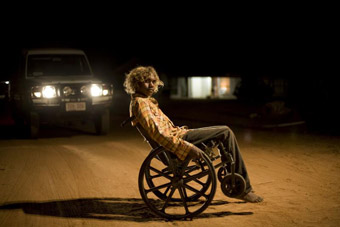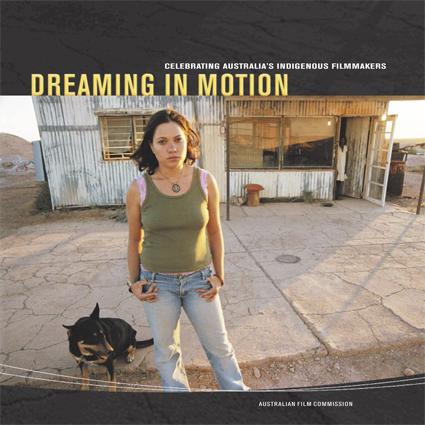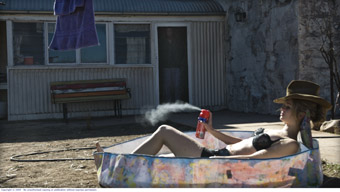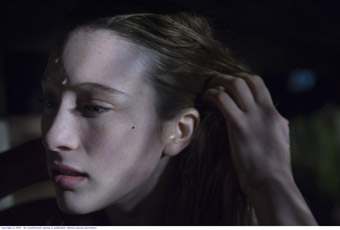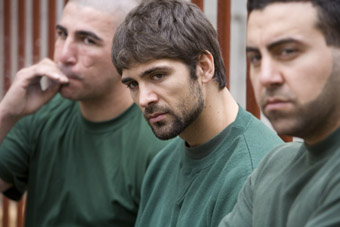September 2009

Autonomous Improvisation V.1
Wade Marynowsky
Autonomous Improvisation V.1
Since its inception in 1992 Primavera has become one of the most highly anticipated shows in the Museum of Contemporary Art’s yearly program, offering a selection of works by Australian artists under 35—a promise of thing to come. This year guest curator Jeff Khan, known for his artistic direction of Melbourne’s emerging and experimental arts festival Next Wave, scattered around the city from underpasses to art spaces, has (not surprisingly) focused on interdisciplinary and expanded practices that engage social connectivity.
But selecting artists for a major art institution exhibition who “propose a departure from fixed studio practices and exhibition-focussed styles of art making” (Jeff Khan, catalogue essay) can be as problematic as it can be progressive.
One of the highlights of Primavera, the performance project Pie (2009), by collaborative duo spat + loogie (Kat Barron and Lara Thoms) with Willoh S Weiland, serves as a key example. Dressed as waiters on the MCA lawn spat + loogie invite whoever is game to sit with various curators who have been recruited for the task, for one to one 10-minute discussions. The duo offer inspiration by providing a ‘menu’ of accessible and witty topics that invite probing questions around the nature of contemporary art, including “Is skateboarding art if you slow it down?” and “Are these tourists making video art?” Offering participants the opportunity to throw a cream pie in the curator’s face at the conversation’s conclusion, spat + loogie ensure that each pays the price for stuffy art-speak or meaningless waffle.
But blink and you’ll probably miss it. Taking place just five times over the course of Primavera and with only a few tokenistic cream pies and some photographs in the gallery, Pie raises the wider issue of how performative or ephemeral practices can sustain a satisfactory and much needed presence within the institutional sphere. The beauty of Pie is that it values its participants and engages art goers and random passersby alike, but it’s disappointing that the majority of Primavera visitors will simply miss out.
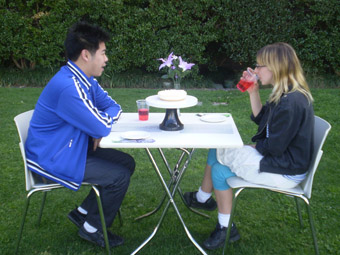
Pie, Primavera 2009, MCA
spat + loogie
Pie, Primavera 2009, MCA
In contrast Christopher LG Hill and Andy Best both explore the social act of art making via collaborative projects that result in substantial gallery exhibits. Hill investigates ideas of value and exchange through collaborations with his art peers that often generate sculptural installations, such as Clique (2009) in Primavera. Clique consists of a democratically arranged ring of modified, almost anthropomorphic chairs interspersed with subtle sculptural assemblages. As if standing in for their makers they reflexively symbolise the collaborative process and open dialogue that created them, while Best’s practice revolves around the documentation and promotion of a semi-fictional art community called Oom—a small group of young trendy artists (his friends) who get sloshed and smoke spliffs, make naive paintings that appropriate cult symbolism, play in the woods and sleep in caravans. His installation in Primavera includes grainy mobile phone photographs, access to the Oom website and, as the centrepiece, the Oom Unit (2009), a small caravan made of logs, housing an unmade bed littered with peppermint tea and sesame snaps—think “Tracy Emin quits the London scene to become a gypsy.” However, the artists’ installations, symbolising the ‘aftermath’ of their social connections, aren’t as compelling as the territory they explore conceptually and performatively.
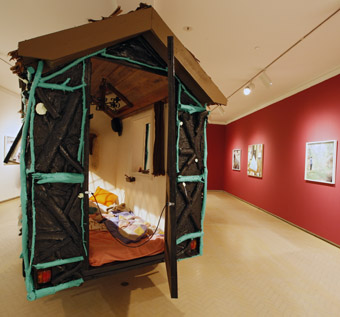
Oom Unit, Primavera 2009, MCA
Andy Best
Oom Unit, Primavera 2009, MCA
Wade Marynowsky and Michaela Gleave offer more satisfying experiences. Marynowsky’s Autonomous Improvisation V.1 (2007), re-casts Sydney’s performance art community into a B-grade horror movie spectacle. With digital candelabra, warped sound styling and ominous lighting, he improbably combines automated computer technology and 19th century gothic kitsch. As individual improvisations appear in stilted bursts and in randomised sequencing across three screens, surreal narratives emerge that create an entertaining and provocative metaphor for ‘community.’
The outer appearance of Michaela Gleave’s Raining Room (Seeing Stars) (2009) belies the presence of a romantic and bewitching phenomenon that surprises you once inside. There, continually falling, harvested rain drops glisten and flicker like diamonds in the dark. But beyond simply housing a saccharine illusion the exposed nuts and bolts of the external architecture and visible rain-making apparatus ask us to consider the entrenched infrastructure that distances urban dwellers from a connection with the natural world.
The remaining works in Primavera are comparatively unassuming but reward contemplation. The result of Christine Eid’s research into taxi-drivers in Lebanese-Australian communities is wall mounted rear view mirrors and taxi lights bearing drivers’ names. While this verges on the literal, the accompanying short film, Transit (2006), is a sensitive and emotional account of the experiences of the artist’s father as a cab-driver.
Kinetic artist Ross Manning creates everyday automata from playful junk assemblages that produce alluring and colourful visual effects from refracted and mediated light. His confusingly complex yet lo-fi constructions wryly invite us to question our reliance on the ‘invisible’ technologies that permeate modern life.
Rather more serious in tone is West Australian artist Roderick Sprigg’s installation Mechanical Nuisance (2008), an investigation of masculinity within isolated farming communities. Using discarded safety mechanisms from agricultural equipment, Sprigg has constructed a dining table that darkly resembles a sort of torture chamber. Together with video projections of himself and his grandfather at work, Sprigg’s installation sombrely suggests that despite isolating and arduous work, these men feel happier out in the fields than in their own homes.
Jeff Khan’s signature on this show is clear in the strong thematic association between works, playful cross-contamination (between Hill and Gleave) and the somewhat risky inclusion of performative and non-autonomous art forms. The show proposes an exciting new future for Primavera as a platform for dynamic practices—both artistic and curatorial. While overall the work in Primavera 2009 offers less of the wow factor than past shows, this community-minded grass-roots Primavera is more of a grower.
A longer version of this review will appear in RealTime 93.
Andy Best, Christine Eid, Michaela Gleave, Christopher LG Hill, Ross Manning, Wade Marynowsky, Roderick Sprigg, spat+loogie with Willoh S Weiland, Primavera 2009, curator Jeff Khan, MCA, Sydney, September 9-November 22
Images are courtesy the artists and the MCA
RealTime issue #92 Aug-Sept 2009 pg.
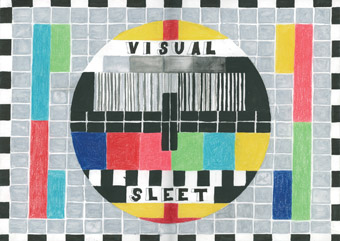
Elvis Richardson, still from TELEVISUALS: SALUTE ELVIS
image courtesy the artist & Hugo Michell Gallery
Elvis Richardson, still from TELEVISUALS: SALUTE ELVIS
At Fremantle Arts Centre, Come Hither Noise invited multi-sensory reactions with sound, video and visual art from eight Australian and international artists, as part of the Totally Huge New Music Festival. Aimed at creating aural, visual and spatial juxtapositions, Come Hither Noise encompassed music, new media, installation and a range of 2D and 3D forms.
Mark Brown’s Detritical SFPS deployed giant, antique fire extinguishers salvaged from the old South Fremantle Power Station, complemented by a speaker issuing distorted instructions for their operation and a screen displaying monochrome footage from the derelict site. The extinguishers, resonating to a tone set by Brown, sang like hot water pipes while flakes of old paint danced on the distorting speaker. Brown is interested in sites of decay and ruin, and his “spatial-sonic atmosphere” suggested the monumental qualities of the defunct building. The occasional intrusion of mysterious piano tinklings—actually emanating from a different work in the same room—inadvertently hinted at nostalgia and drew attention to the musicality of Brown’s sounds.
Sound crossover was sometimes problematic, and most so for Sriwhana Spong: the afore-mentioned piano sounds formed part of Spong’s The Birds, an experimental collaboration in which a photograph inspired a 21-second music piece by Godfrey de Grut, in turn inspiring a collage by Simon Oosterdijk and Kelvin Soh. Here, the three elements seemed not so much to cohere as to be linked by theme and process.
Playful, cohesive and illuminating, Ross Manning’s two works gave differing insights into relationships between sound and movement. In Dissonant Rhythm a length of plastic clothes-line strung between electric fan motors was set into spinning motion by viewer movement. The resulting standing wave patterns struck intermittently at sets of PVC-coated wire prongs, mounted like improvised, giant kalimbas on the wall. Chaotic by comparison, his Alpha Waves was a fascinating jumble of cables, sensors, cardboard vanes, gaffer tape and fans that created moving, pulsing relationships tied to a phasing bass drone.
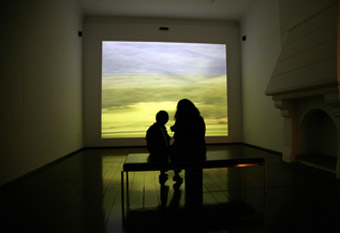
John Conomos, still from Lake George (After Mark Rothko)
image courtesy the artist & Roslyn Oxley Gallery
John Conomos, still from Lake George (After Mark Rothko)
John Conomos’ Lake George (after Mark Rothko) was one of a number of works that suggested the resonance of sound and sight in the landscape. Featuring a slowed-down soundtrack of moving vehicles, wind and water, the slow-panning video of Canberra’s Lake George was a shifting blur of colours, resembling a Rothko canvas. A “tribute to the long take”, it evoked an eerie, mysterious landscape, and the soundtrack made passing cars and trains integral to, rather than imposed on, this coloured, moving world.
Inspired both by obsolete and new technologies, Elvis Richardson’s hand-drawn animations and ‘copyright free’ soundtrack combined in a small-screen exploration of the old-fashioned TV test pattern, TELEVISUALS: SALUTE ELVIS. Richardson’s work was mesmerising in the way that bad ads are. Over the changing coloured squares and lines, pointed anagrams of the work’s title popped up—VISUAL SLEET, STEAL US LIVE, IT VALUELESS and many others. It was worth tolerating the collaged, Looney-Toons-meets-talkback soundtrack in order to see what clever word play would appear next.
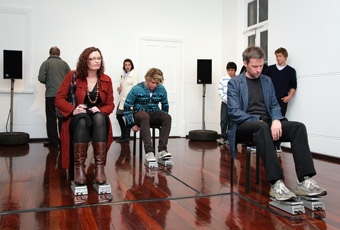
Thomas Meadowcroft, Monaro Eden
image courtesy the artist
Thomas Meadowcroft, Monaro Eden
Berlin-based Thomas Meadowcroft’s soundscape Monaro Eden consisted of recordings from both inside and outside a V2 Monaro engine. The subtle, surround-sound work generated a sense of the car’s hum through a landscape as well as its internal rhythm. Somewhere amid tonal variations and harmonics—which visitors adjusted using foot pedals—strains of violin seemed to impinge. Whether this was part of the work is unclear, but certainly the MGM fanfare belonged to the adjacent TELEVISUALS, not Meadowcroft’s homage to Holden’s classic car.
For the four-minute video, Twist, Sam Smith combined sampled filmed landscapes with a wistful soundtrack, more musical accompaniment than aural plane. Tins of ‘green screen’ paint revolved like cheap-advert invitations or alien spaceships. The work playfully deconstructed the artifice of screen technologies, but the mood was less of parody than melancholy; its deliberate clunkiness seeming to reinforce a poignant lament for lost technological innocence.
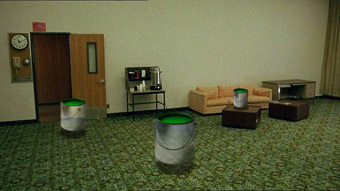
Sam Smith, Twist
image courtesy the artist
Sam Smith, Twist
An archival hospital image and wall-mounted statement stood in for Richard Crow’s Imaginary Hospital Radio, available online at ABC Classic FM, in which synthesised crackles and rumbles morph into cheery birds, soft voices and weird machine sounds. Footsteps, clicks and rattles evoke trolleys rumbling down long corridors; the changing arrays of precise, analogue sounds subverting the notion of ‘hospital radio’ designed to keep patients ‘happy’.
The works of Come Hither Noise, diverse in approach and impetus, together provided a substantial survey of current sound/visual art from Australia and beyond. Subtle linkages became apparent: the landscapes evoked by Conomos, Meadowcroft, Smith and arguably Brown; the music-like elements from Smith, Spong, Crow and Manning. More than a listening exercise, the exhibition combined subtlety and playfulness, displaying a unifying concern with aesthetic balance over dissonance. It also issued an invitation to think, integrating sound firmly into the ‘art’ experience and engaging the intellect through the under-used medium of the ears.
Come Hither Noise—an exhibition of sound works, artists Mark Brown (Aus), John Conomos (Aus), Richard Crow (UK), Ross Manning (Aus), Thomas Meadowcroft (Aus/Germany), Elvis Richardson (Aus), Sam Smith (Aus), Sriwhana Spong (New Zealand), curator Jasmin Stephens, Fremantle Arts Centre, Fremantle, Aug 1-Sept 20
RealTime issue #92 Aug-Sept 2009 pg.
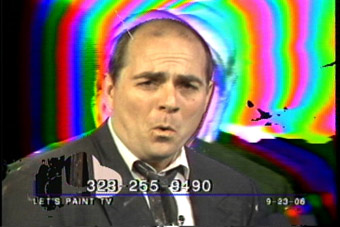
John Kilduff, Let’s Paint TV
photo courtesy of the artists
John Kilduff, Let’s Paint TV
electrofringe 2009
Now up to its 12th incarnation, the recently announced program for Electrofringe 2009 leaves no doubt that its agenda to celebrate the emergent and extraordinary within the media arts landscape remains firm. There are over 55 events including artist and project presentations, panels, screenings, gigs and exhibitions. Highlights are many, including Temp° Sauna, a mobile DIY sauna built in Civic Park by Mika Meskanen (Finland); the collaborative multimedia mayhem of John Kilduff’s Let’s Paint TV (US); large scale projections over Newcastle’s cityscape by Suburban Giants; and an attempt to soundproof the city by Lauren Brown. The gigs are particularly varied, ranging from the Kontakte, a concert by Ensemble Offspring with Pimmon at the Newcastle Conservatorium, to the usual rowdy TINA Showcases at the Cambridge Hotel, to Quiet Appreciation sessions at Renew Newcastle Church.
What distinguishes Electrofringe most is its emphasis on skills development and this year you can learn how to create your own virtual world through OpenSim with Andrew Burrell; make plastic sing with Guillaume Potard; explore telepresence with S.W.A.M.P (US); and hack your mobile phone with Christian Haines (US). There’s also a plentiful supply of panel discussions, with several focusing on tactics for survival for endangered media artists. And if that’s not enough, Ben Denham may actually be able to convince you to fly! But there’s even more—Electrofringe is but one of five festivals in that magnificent monster, the This Is Not Art Festival, which will be celebrating its 10th birthday.
Electrofringe & This Is Not Art, Oct 1-5, Newcastle, NSW http://www.electrofringe.net http://www.thisisnotart.org/
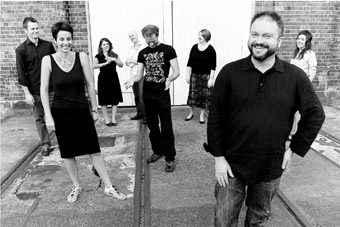
Ensemble Offspring, Electrofringe 2009
photo courtesy of the artists
Ensemble Offspring, Electrofringe 2009
wayfarer v 2: urban agents, melbourne
Media artist Kate Richards and performer Martyn Coutts are taking their locative, multiplayer media game, Wayfarer, to Melbourne after successfully premiering version 1 for Performance Space at Sydney’s CarriageWorks (http://www.realtimearts.net/article/issue81/8720). Version 1 was played by audiences tracking and directing a group of performers. In version 2, this time on the streets, the audience who sign on become the performers.
In the artists’ words, “teams of urban agents armed with mobile phones…will create and enact socially responsible experiences—large or small, planned or improvised including art projects, urban renewal, improvisation and drifting, liminal explorations, parkour and skate, gifting, green living/carbon neutrality/light footprint, flash mobs—anyway and anywhere they want to engage ethically and positively in the city. Videos of the experiences are steamed from players’ mobile phones directly to the Wayfarer website. Here web visitors, futurists and expert commentators in the field of social media will view, discuss and vote on the videos and drive a broader discussion about social responsibility.”
For information and to register to play, go to www.wayfarer.net.au or info@wayfarer.net.au; Arts Centre, Melbourne, Oct 26-31, Nov 2-7
andante workshop, melbourne
Tashmadada, Open Channel and ACAPTA are inviting physical theatre practitioners, actors, dancers, circus performers, production personnel, riggers, multi-media artists, musicians and costume and set designers to Andante, a 10-day workshop with Younes Bachir, actor and collaborator with the Spanish performance company La Fura dels Baus. The workshop will culminate in a public performance. “Younes will expose the participating artists to his personal experience with Furas dels Baus of the different dramatic, plastic and spatial skills involved in the realization of their performances.” In his 15 years with the company he has participated in developing a performance language, Furan, “based in the synergy between disciplines and the coexistence of different techniques and perspectives to theatre.”
Andante, Open Channel Shed 4, Docklands, Melbourne, Nov 4-14;
For more information contact Deborah:info@tashmadada.com; or Gail: gailkelly@acapta.net
lynette wallworth: connected by light, ABC TV
A documentary on an Australian new media artist is a rarity indeed, so it’s heartening to see that ABC TV will be screening Connected by Light. The film documents the artist’s career and creations with a focus on her exhibition, Duality of Light, at Adelaide’s Samstag Museum early in 2009 as part of the Adelaide Film Festival and scheduled for the 2010 Sydney Festival. ABC1, Sept 22; ABC2, Nov1,10pm
rong rong and chinese photography
If you were intrigued by Dan Edwards’ account of the first major photographic gallery in China in RealTime 92 (http://www.realtimearts.net/article/issue92/9512), you’ll want to read the full interview with Rong Rong, co-director of Beijing’s Three Shadows Photography Art Centre. (http://www.realtimearts.net/article/issue92/9557).
lucas abela: the interview
In RealTime 92, Gail Priest and Dan Edwards reported on Lucas Abela’s visit to China where he toured with his first band, a collaboration with Chinese artists. In the interview with Priest (http://www.realtimearts.net/article/issue92/9556), Abela elaborates on his Asialink residency and where it will take his work in Australia.
RealTime issue #92 Aug-Sept 2009 pg.
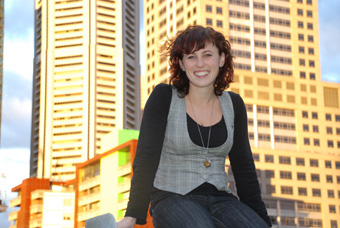
Emily Sexton
Emily Sexton, the Melbourne Fringe’s Creative Producer, recently introduced me to highlights of the 315 programmed shows, emphasising the festival’s local character (80% of the acts are Melbourne-based); the year-round evolution of each program; and the pro-development approach to nurturing artists. It’s a rational model for improving the roulette spin that comprises the fringe festival experience for brave audiences.
Selected groups, mastering the art of self-producing on the run, are offered free rehearsal space and 20 hours each of mentoring from leading artists and programmers like choreographer Lucy Guerin, Melbourne International Arts Festival director Brett Sheehy and Rawcus’ artistic director Kate Sulan. The realisation of the mentoring program is aided by The Arts Centre’s Full Tilt program.
Independent artists frequently work against great odds, so any help is bound to lift the calibre of their work and, in turn, benefit the festival. As well, a sense of community is built across the year, says Sexton, through forums on touring and producing and informal Friday afternoon chats, palpably reducing the sense of working in isolation.
From the list of artists and companies Sexton and I discussed, and some she enthusiastically filled me in on, like bettybooke, I made a shortlist of shows that looked attractive, if more for their form than alleged content (never a good guide), or from names I recognised from the ranks of newly emerging talent.
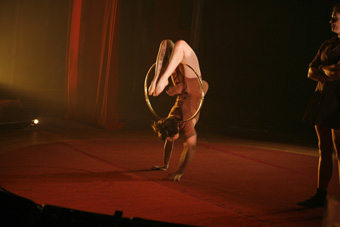
Jess Love, And The Little One Said
photo © the artist
Jess Love, And The Little One Said
Established performers include scary funsters, the Snuff Puppets, who will present their “cabaret club gone mad” show, Snuff Club, and circus provocateurs The Candy Butchers premiering a new solo work, titled And the little one said. Also in the physical theatre realm, Skye Gelman (of Scattered Tacks fame, http://www.realtimearts.net/article/issue90/9431) will premiere Asleep in a Secret: “Poetically stuttered personal stories about the reality of living in a storage cupboard…Anti-theatrical circus and abstract slide projection.”
It’s intriguing to see a Live Art category in the program—the open-ended ‘form’ is spreading. Here it includes the idiosyncratic bettybooke, an ensemble who alternate between making theatre works and “[e]xploring ways to allow audience members to find a point of relaxed engagement, involvement and activity in the imaginal and real worlds unfolding before them” (http://www.bettybooke.com). In the 2009 Fringe they’ll work with pedestrians, mobile phones and iPods. Elsewhere inventive writer-performer Willoh S Weiland will curate The Mapping Room, “an evolving installation” incorporating live art, SMS, drawing, video “and a lecture series to explore notions of scale and temporality.”
In Letters to Isaac, “multi-platformed neo-troubadour Roxby Greenstone” will present “a melodrama told in 18 short letters delivered via text, radio and online.” In a performance-installation mix, Sydney’s Tiger Two Times will welcome audiences into the self-contained “fake nature” of the urban world before letting the “outside” in.
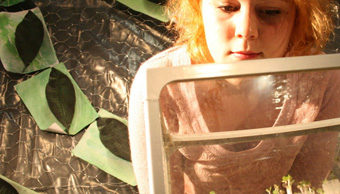
Tiger Two Times, Nature League
photo © the artists
Tiger Two Times, Nature League
The performance program includes A Bit of Argy Bargy, comprising two contributions from leading young playwright Tom Holloway. First he’s part of a team who’ve developed an unlikely vaudevillian approach to a demanding subject in The Suicide Show. He’s also written And no More Shall We Part, about a 30-year old marriage, to be performed by Dennis Moore and Margaret Mills and directed by Martin White. In Attract/Repel, Ming-Zhu Hii and the Melbourne Town Players will address race and identity, ‘them and us’, while Elbow Room (also appearing in the Brisbane Festival’s Under the Radar with their award-winning There) present a new work titled a tiny chorus. Renowned for their re-workings of classic plays, Hayloft will premiere something quite different, Yuri Wells, an intimate solo performance about “an aged care nurse living in solitude.” Hmm.
Doubtless these performances will, in varying degrees, provide welcome antidotes comics and cabarets, while the live art works will lead audiences into newly foreign territory where anything can be performative, including themselves. Russian roulette?
2009 Melbourne Fringe Festival, Sept 23-Oct 11
http://www.melbournefringe.com.au
RealTime issue #92 Aug-Sept 2009 pg.


